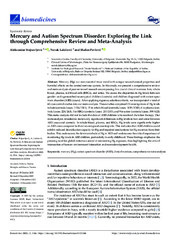Приказ основних података о документу
Mercury and Autism Spectrum Disorder: Exploring the Link through Comprehensive Review and Meta-Analysis
| dc.creator | Stojsavljević, Aleksandar | |
| dc.creator | Lakićević, Novak | |
| dc.creator | Pavlović, Slađan Z. | |
| dc.date.accessioned | 2024-03-11T10:18:05Z | |
| dc.date.available | 2024-03-11T10:18:05Z | |
| dc.date.issued | 2023 | |
| dc.identifier.issn | 2227-9059 | |
| dc.identifier.uri | http://cherry.chem.bg.ac.rs/handle/123456789/6455 | |
| dc.description.abstract | Mercury (Hg) is a non-essential trace metal with unique neurochemical properties and harmful effects on the central nervous system. In this study, we present a comprehensive review and meta-analysis of peer-reviewed research encompassing five crucial clinical matrices: hair, whole blood, plasma, red blood cells (RBCs), and urine. We assess the disparities in Hg levels between gender- and age-matched neurotypical children (controls) and children diagnosed with autism spectrum disorder (ASD) (cases). After applying rigorous selection criteria, we incorporated a total of 60 case-control studies into our meta-analysis. These studies comprised 25 investigations of Hg levels in hair (controls/cases: 1134/1361), 15 in whole blood (controls/cases: 1019/1345), 6 in plasma (controls/cases: 224/263), 5 in RBCs (controls/cases: 215/293), and 9 in urine (controls/cases: 399/623). This meta-analysis did not include the data of ASD children who received chelation therapy. Our meta-analysis revealed no statistically significant differences in Hg levels in hair and urine between ASD cases and controls. In whole blood, plasma, and RBCs, Hg levels were significantly higher in ASD cases compared to their neurotypical counterparts. This indicates that ASD children could exhibit reduced detoxification capacity for Hg and impaired mechanisms for Hg excretion from their bodies. This underscores the detrimental role of Hg in ASD and underscores the critical importance of monitoring Hg levels in ASD children, particularly in early childhood. These findings emphasize the pressing need for global initiatives aimed at minimizing Hg exposure, thus highlighting the critical intersection of human–environment interaction and neurodevelopment health. | |
| dc.language | en | |
| dc.relation | info:eu-repo/grantAgreement/MESTD/inst-2020/200161/RS// | |
| dc.relation | info:eu-repo/grantAgreement/MESTD/inst-2020/200007/RS// | |
| dc.rights | openAccess | |
| dc.rights.uri | https://creativecommons.org/licenses/by/4.0/ | |
| dc.source | Biomedicines | |
| dc.subject | autism spectrum disorder (ASD) | |
| dc.subject | clinical matrices | |
| dc.subject | comprehensive meta-analysis | |
| dc.subject | mercury (Hg) | |
| dc.title | Mercury and Autism Spectrum Disorder: Exploring the Link through Comprehensive Review and Meta-Analysis | |
| dc.type | article | en |
| dc.rights.license | BY | |
| dc.citation.volume | 11 | |
| dc.citation.issue | 12 | |
| dc.citation.spage | 3344 | |
| dc.identifier.doi | 10.3390/biomedicines11123344 | |
| dc.type.version | publishedVersion | |
| dc.identifier.scopus | 2-s2.0-85180667157 | |
| dc.identifier.fulltext | http://cherry.chem.bg.ac.rs/bitstream/id/34946/bitstream_34946.pdf |


